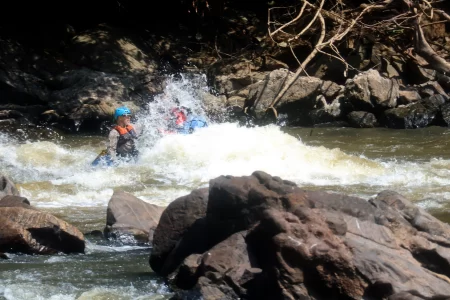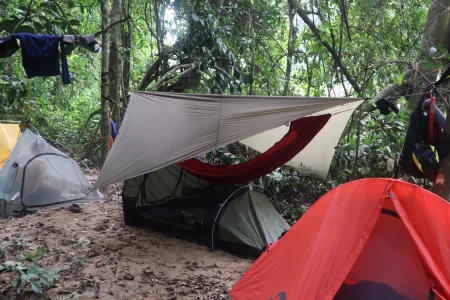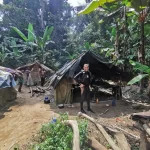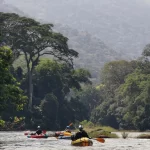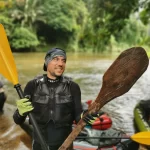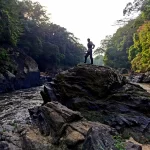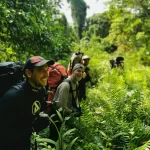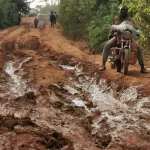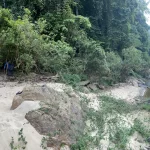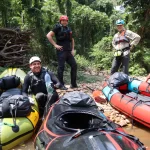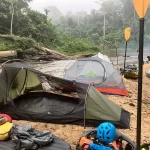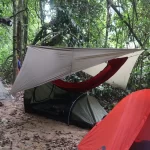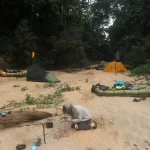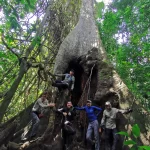MAKOMBE packrafting expedition, or river exploration of the Cameroonian JUNGLE.

As the most experienced in navigating through the dense equatorial rainforest, Dominik proposed the idea.
The Makombe River, meandering through the dense jungle of the primary equatorial forest, had been tempting him for a long time.
Analysis of satellite images and previous exploration of the Nkam River, into which the Makombe flows, did not reveal much… except for the dense jungle and the mountainous character of the river.
Therefore, we had to prepare for two weeks of the unknown, with the wild nature and everything that the fauna and flora of Central Africa could offer.
The plan was as simple as ABC:
Pack the equipment for living in the jungle, along with food for at least two weeks, and a packraft (an inflatable whitewater kayak) with a paddle, into waterproof backpacks. The total weight could not exceed about 25 kg, so we could move relatively freely through the jungle. Although we planned to cover most of the route downstream, in reality, we often had to bushwhack through the jungle or slog through waist-deep water while dragging all our equipment upstream, accompanied by, as it turned out, skittish crocodiles :)
It took epic several hours in a shaky pickup truck struggling with a road that, for most of its length, did not belong to the category of paved roads to reach the launching site for our boats.
Finally, we launched our packrafts, and our journey down the unknown river began.
The adventure
The epic adventure was full of unexpected twists and turns, alternating between dense wilderness, rocky rapids, and sometimes waterfalls (which we had to circumnavigate). We also encountered the idyllic lazy river with plenty of noisy birds, sometimes forest buffaloes or elephants. From time to time, we met fishing nets set up by friendly local fishermen.
After a full day of battling on the river, with short breaks for a quick and balanced meal, our search for a landing site intensified around 5:00 pm, as after an hour, the black African night would fall.
The matter was not easy because the jungle did not allow us to choose the desired overnight spot with a view of the surrounding volcanic mountains (the highest of which is Mount Cameroon, measuring 4040 meters above sea level).
We took what the jungle gave us – sometimes it was a watering hole for elephants, another time, a rocky sandbar in the river.
Occasionally we came across a miracle in the form of sandy islands of the perfect size for five exhausted travelers to spend the night.
However, the main factor in choosing a camping spot was always relatively flat terrain with access to relatively dry wood for the campfire – the only source of hot water (filtered from the river through a ceramic filter).
Choosing the freeze-dried meal for dinner, which would be appropriate for the whole day spent on the river, became a mystery.

We also took great care (due to my orthodoxy) to brew tea with freshly chopped ginger after the evening meal – I carried it laboriously throughout all those days, and even the leftover ginger came back with me to Poznan.
In all these camping activities, the indispensable hit was the telescopic bellows and flint from BUSHMEN https://bushmen.pl/produkt/krzesiwo-bushmen-trapper-set/ as well as the essential head mosquito net – also available from BUSHMEN: https://bushmen.pl/produkt/head-net-desert/
The second activity, alongside dinner, after a full day of intense river activities, was sleeping, and here the well-thought-out products of the BUSHMEN shelter system were fully supportive. As they couldn’t predict the conditions in the jungle (water level and the availability of river pools or the possibility of getting to land), I secured myself in two ways: a tent and a hammock, and for both, I used an ultra-light and handy tarp 2×3 weighing just over 300 grams and minimal volume https://bushmen.pl/produkt/tarp-ultralight-3×2/ with very handy cords/tensioners that only needed a system of folding them to avoid tangling. For tarp tensioning, I also used elastic expanders https://bushmen.pl/produkt/expandory/, which also served as stabilizing guy lines for the hammock.
For sleeping on the ground, I chose the mosquito tent Core-tent LODGER https://bushmen.pl/produkt/core-tent-lodger-olive/ covered or hung in various tarp configurations (due to high temperatures and high humidity, I used the covering only in case of obvious rain). The tent turned out to be a perfect choice for the expedition to the Cameroonian jungle, as it is relatively lightweight, very breathable, and enormously spacious. It has two entrances, which makes the organizing space (sleeping mattress, the same one I floated on in the packraft) very convenient.
I inserted it through the technical entrance from the front, while I used the comfortable side entrance.
To achieve full happiness and avoid duplicating equipment, the only thing I’m missing is for it to also serve as a hammock, and maybe it would be even better if it were freestanding, but that aspect can always be somehow resolved.
In loose ground conditions, Sand & Snow stakes have become a great help https://bushmen.pl/produkt/ultralight-sledz-sand-snow/ – they may not be the lightest, but they effectively serve the function of stable fastening.
The ease of use and comfort provided by this tent is the predominant factor in making friends with it for a longer period of time. In situations where camping by the river was limited (fortunately, there were relatively few of them), I used a hammock with a mosquito net in a set called Jungle-Set https://bushmen.pl/produkt/jungle-hammock-set/, which provides complete protection against insects, and it is worth noting that Cameroon is one of the top countries with malaria! Fortunately, there were few mosquitoes in the jungle, and the risk of malaria infection decreases as one moves away from human settlements (we were mostly in completely remote areas in the heart of the equatorial primary forest).
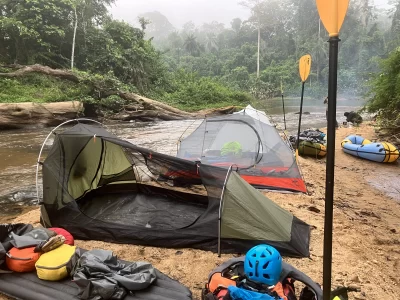
A hanging shelter in the jungle has one advantage over a tent – no contact with the forest floor – of course, we cleared the camping spot very laboriously, but never 100%. Helpful accessories for effectively organizing a hanging accommodation were maybe smaller, maybe less noticeable but significantly affecting the efficiency of hanging, namely: whoopie slings, which in the BUSHMEN version have a helpful hook increasing their usability and come in several colors which can be used to distinguish them (front, back) https://bushmen.pl/produkt/whoopie-slingi/, as well as Soft Shackles that are lighter than carabiners, more mobile, and more compact https://bushmen.pl/produkt/jungle-hammock-set/.
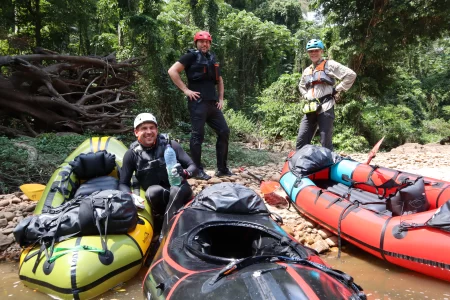
The expedition received an exaequo, along with two other expeditions, a distinction at the festival KOLOSY !
[/vc_column_text][/vc_column][/vc_row]

